|
 Auxiliary Dipmeter Presentations
Auxiliary Dipmeter Presentations
Dipmeter computation data are displayed graphically and in tabular
form in many different formats, to facilitate interpretation.
The standard output consists of a raw data plot, arrow plot, and
numerical listings, many of which have been shown earlier in the
discussion of tool and program theory. The balance are optional
at extra cost. They are usually run only after evaluation of the
standard output.
 Stick Diagrams
Stick Diagrams
The cross section plot or stick diagram, is a two dimensional
cross section representing the dipping bedding planes at a pre-selected
azimuth. It shows the apparent dip of each
bedding plane as it would cross the borehole at the specified
cross section azimuth. A common use is to establish the dip expected
between a well with computed dipmeter information and a projected
well close to the original well, or between two wells.
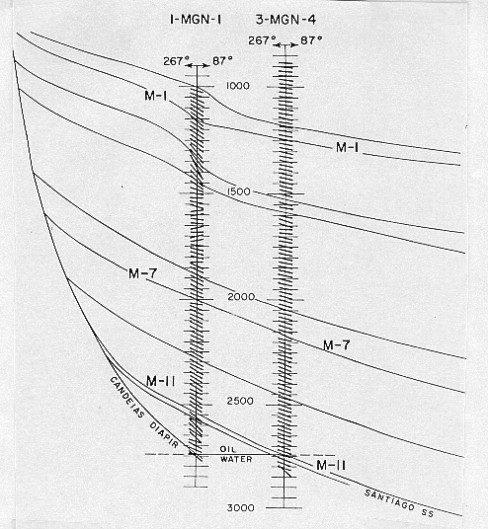
Stick diagram in steep regional dip - gamma
ray (not shown) was used to aid correlation
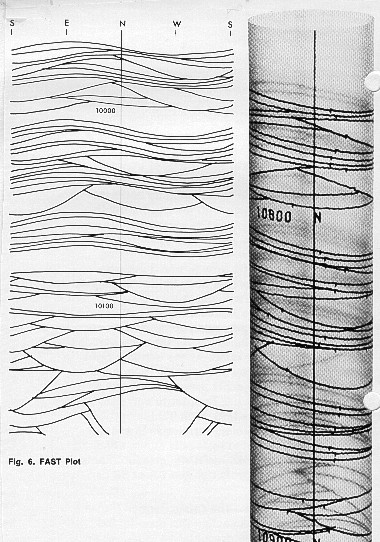 This
allows the person using the plot to estimate the depth to particular
horizons in the new well. Another use is in correlating formations
from one well to another when both have dipmeter data. The ability
to compute a stick diagram with apparent dip along any defined
azimuth makes it easy to project formation tops from one well
to another. The direction of the stick plot can also be presented
parallel and/or perpendicular to a seismic line and the apparent
dips compared with the dips observed on the seismic line. This
allows the person using the plot to estimate the depth to particular
horizons in the new well. Another use is in correlating formations
from one well to another when both have dipmeter data. The ability
to compute a stick diagram with apparent dip along any defined
azimuth makes it easy to project formation tops from one well
to another. The direction of the stick plot can also be presented
parallel and/or perpendicular to a seismic line and the apparent
dips compared with the dips observed on the seismic line.
Cylindrical plot in complex cross bedding

 Cylindrical Plots
Cylindrical Plots
The cylindrical plot is a two-dimensional presentation that has
the appearance of the borehole split along the south axis. When
placed in a transparent cylinder, the bedding
planes appear as they would in an oriented core.
The
cylindrical plot is especially useful for locating the position
of faults or major unconformities where these are reflected by
a change in dip direction or magnitude. The STRATIM and DIPVUE
images described earlier offer the same advantages.
 Schmidt Plots
Schmidt Plots
The modified Schmidt diagram is used to determine structural dip
when it is hard to find from the rrow plot. The paper is polar
with North at the top. Dip magnitudes are represented by concentric
circles. The plot is divided into cells at 1 degree magnitude
and 10 degree azimuth; the dots are plotted for all dips computed.
In some cells there may be no dots; in others, one dot; in still
others, two or more dots. The plot can be generated by hand or
by computer.
The
dots will fall into distinctive groupings or patterns, which can
be outlined by contour lines. Structural dip is an elongated pattern
hugging the outer rim of the plot, possibly extending over a wide
range of azimuths. The remaining dips (slope and current patterns)
will plot in rough triangles with their apexes pointing toward
the center of the plot.
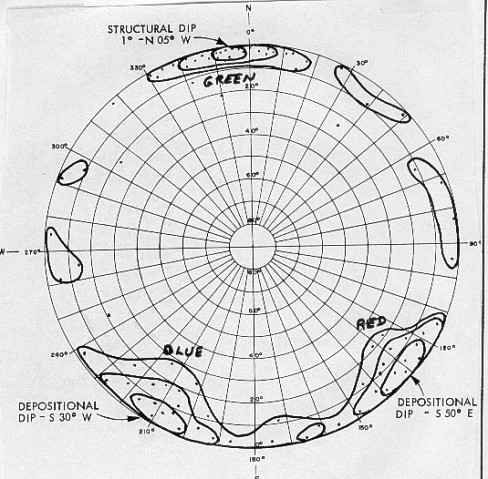
Schmidt plot separates regional from stratigraphic
dips
 Azimuth Frequency Plots
Azimuth Frequency Plots
Azimuth frequency plots, often called rose diagrams, are plotted
on polar coordinate paper with north at the top and 10 degree
azimuth increments. The length of each 10 degree segment is proportional
to the number of dips in the interval having that azimuth range,
with zero frequency at the center. The result will be little fans
originating at the center which may be composed of structural
dip and current patterns, often at right angles to each other.
There
is no information in the azimuth frequency plot concerning the
magnitude of dip. This information must come from other plots.
Azimuth frequency diagrams are excellent tools for delineating
bars, reefs, channels, and troughs. An illustrative example is
shown below, along with a schematic diagram of the channel
represented by the frequency plots.
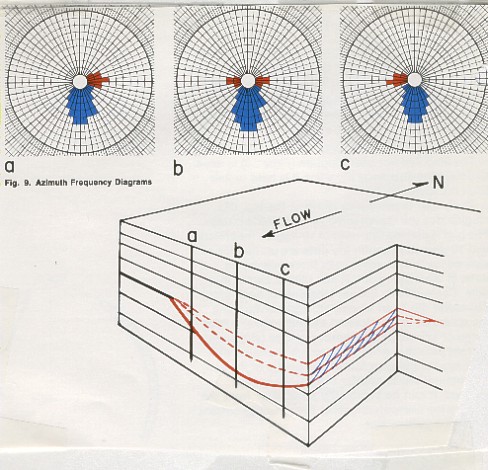
Azimuth frequency plots (rose diagrams) show
preferential sedimentation directions
This
plot is is called a pattern azimuth frequency plot, because dips
belonging to red and blue patterns (to be described later) are
preserved and plotted separately. Blue patterns show direction
of transport and red patterns show direction to the thicker
sand. If plotted in black and white, as is the normal case, the
lobes of the diagram are often still identifiable.
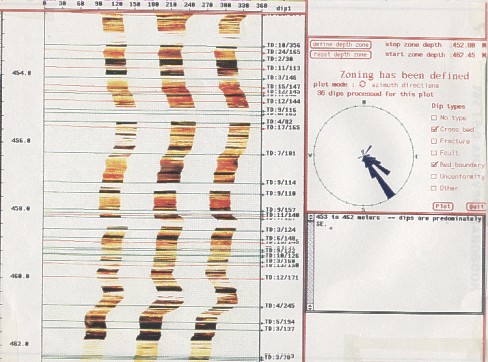
Rose diagrams on FMS Image Examiner
The
arrow plot presented to the customer contains azimuth frequency
plots generated for each 100 ft. interval or other regular interval
as designated by the analyst. These plots are used for general
information concerning the direction of dip for each interval
of the computed analysis. Additional computer generated azimuth
frequency plots can be run over specific zones which have a particular
geologic significance.
These
zones can be the upper and lower boundaries of a formation, the
zone between two faults, the zone between a fault and an unconformity
or any other breakdown which is indicated by knowledge of the
local geology or interpretation of the dipmeter data itself. With
the advent of interactive computer programs, decisions on what
to plot can be made as processing and analysis take place. using the FMS Image Examiner
program.
 Regional Dip Removal Plots
Regional Dip Removal Plots
If structural dip is greater than three or four degrees, it should
be vectorally subtracted from the dips by the computer, leaving
the absolute current and slope pattern dips. This provides better
definition of stratigraphic dips.
The effect can be quite dramatic, and some events may appear after
dip subtraction that were not noticed before.
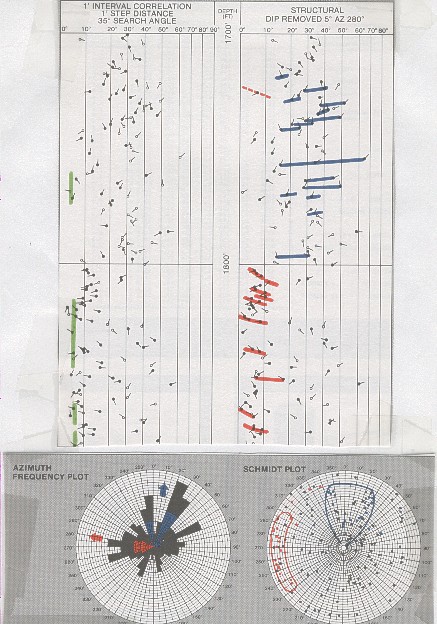
Regional dip removal changes the dip patterns, making
sedimentary interpretation easier
All
the above plots are available in a hands-on mode when using Schlumberger's
Dipmeter Advisor, and most are available on the Atlas Wireline
DIPVUE program.
|

